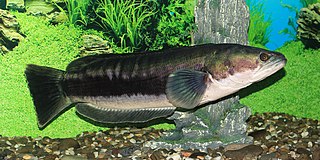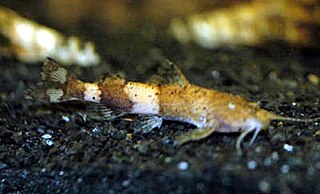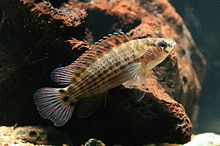
Channa is a genus of predatory fish in the family Channidae, commonly known as snakeheads, native to freshwater habitats in Asia. This genus contains about 50 scientifically described species. The genus has a wide natural distribution extending from Iraq in the west, to Indonesia and China in the east, and parts of Siberia in the Far East. A particularly high richness of species exists in Myanmar (Burma) and northeastern India, and many Channa species live nowhere else. In contrast, a few widespread species have been introduced to several regions outside their natural range, where they often become invasive. The large and medium-sized Channa species are among the most common staple food fish in several Asian countries, and they are extensively cultured. Apart from their importance as a food fish, snakeheads are consumed in some regions as a traditional medicine for wound healing and reducing postoperative pain and discomfort, and collected for the international aquarium pet trade.

Danio is a genus of small freshwater fish in the family Cyprinidae found in South and Southeast Asia, commonly kept in aquaria. They are generally characterised by a pattern of horizontal stripes, rows of spots or vertical bars. Some species have two pairs of long barbels. Species of this genus consume various small aquatic insects, crustaceans and worms.

Pseudolaguvia is a genus of South Asian river catfishes. These species inhabit hill streams and large rivers. P. tenebricosa is found in fast running, clear water; the river has a sandy bottom and numerous rocks and boulders and aquatic vegetation is absent. P. inornata is from clear, shallow, moderately flowing streams with a predominantly sandy bottom. P. muricata is found in clear, shallow, slow-flowing streams with a mixed substrate of sand and detritus; these fish are found amongst detritus in areas with current. P. ferula is also found in swift flowing waters with a mixed rocky/sandy bottom.

Aplocheilus is a genus of killifish in the family Aplocheilidae. Their native range is in South and Southeast Asia, from india to Vietnam and Malaysia, and from Nepal to Sri Lanka. Several species, especially the striped panchax, A. lineatus, are important aquarium fishes.

Garra is a genus of fish in the family Cyprinidae. These fish are one example of the "log suckers", sucker-mouthed barbs and other cyprinids commonly kept in aquaria to keep down algae. The doctor fish of Anatolia and the Middle East belongs in this genus. The majority of the more than 160 species of garras are native to Asia, but about one-fifth of the species are from Africa.

Schistura is a genus of fish in the stone loach family Nemacheilidae native to the streams and rivers of the southern and eastern Asia. Some of these species are troglobitic.
Amblyceps is a genus of fish in the family Amblycipitidae. The genera Amblyceps and Liobagrus are sister group pair that is, in turn, sister to Xiurenbagrus. These species are easily distinguished by the presence of pinnate processes along with the median caudal-fin rays, a prominent cup-like skin flap above the base of the pectoral spine, and the adipose fin largely separate from the caudal fin. In most species the caudal fin is deeply forked; A. apangi and A. murraystuarti differ in having their caudal fin truncate. Amblyceps species may reach about 100 millimetres (3.94 in) SL.

Badis badis, also known as the blue perch or blue badis, is a small species of Asian freshwater fish in the family Badidae of the order Anabantiformes. It is found in ponds, rivers, ditches and swamps in northern India, eastern Pakistan, Bangladesh, Bhutan and Nepal, including the Ganges, Brahmaputra, Mahanadi and Indus basins. It is sometimes kept as an aquarium fish. It is a small, predatory fish that feeds on tiny invertebrates. Maximum total length is around 8 cm (3 in). It is sexually dimorphic, with males growing larger and being more colorful, especially when excited, compared to females. Adult males have blue fins and may display dark vertical bands on the flanks, while the smaller females display little color. Several similar relatives, now recognized as separate Badis species, have historically been confused with Badis badis. Historically the two genera that now make up the Badidae, Badis and Dario, were placed in the family Nandidae; this is no longer the case.

Psilorhynchus is a genus of fish in the family Psilorhynchidae native to South Asia. This genus is the only member of its family. The members of Psilorhynchus are small benthic fishes which occur in rivers and streams with fast to swift currents, hence they are often referred to a torrent minnows. They are distributed in southern Asia, in the Indo-Burma region and the Western Ghats.

Pethia is a genus of small freshwater fish in the family Cyprinidae native to South Asia, East Asia and Mainland Southeast Asia. Some species are commonly seen in the aquarium trade. The name Pethia is derived from the Sinhalese "pethia", a generic word used to describe any of several small species of cyprinid fishes. Most members of this genus were included in Puntius, until it was revised in 2012.

The Badidae or the chameleonfishes are a small family or ray-finned fishes which has been placed in the order Anabantiformes. Despite their apparent affinity to other Anabantiforms, the 5th edition of Fishes of the World classifies the family as being a sister to the Anabantiformes, along with the Nandidae and Pristolepididae in an unnamed and unranked but monophyletic clade which is a sister to the Ovalentaria within the wider Percomorpha. Members of this family are small freshwater fish that are found in Bangladesh, Bhutan, China, India, Laos, Myanmar, Nepal, Pakistan and Thailand. The largest is Badis assamensis that reaches a standard length of up to 7.5 cm (3 in), while the smallest, Dario dario, does not exceed 2 cm (0.8 in).

Dario is a genus of very small chameleonfishes native to streams and freshwater pools in China (Yunnan), India and Myanmar. Depending on exact species, they are up to 1.5–3 cm (0.6–1.2 in) in standard length, and reddish or brownish in colour.

Pseudosphromenus cupanus, also known as the spiketail paradisefish is a species of medium-small gouramies native to southern India and Sri Lanka. This species is often found in shallow, slow-moving or stagnant water, such as ditches and paddy fields. P. cupanus eats insects and zooplankton. Males are known to gather eggs in its mouth, and to guard the nest after eggs are hatched. The male may build many nests, and periodically move the eggs between them.

Badis khwae is a species of freshwater ray-finned fish from the family Badidae that is native to Thailand. First described in 2002, this species grows to a length of 2.9 cm.

Laubuka is a genus of cyprinid fish found in South and Southeast Asia.
Danio annulosus is a species of Chain danio fish in the family Cyprinidae in Danio genus. The species is named and described jointly by Sven O Kullander, M.D Mizanur Rahman, Michael Noren and Abdur Rob Mollah in 2015 in association with the Department of Zoology, Swedish Museum of Natural History, Sweden and the Department of Zoology, University of Dhaka, Bangladesh. The study and paper on Danio annulosus was published in ZooTaxa both online and in print in the same year (2015). It was collected from a small pool at the bottom of the Shuvolong Falls in the Kaptai Lake system in Rangamati district in the Chittagong division, Bangladesh. The species name annulosus is derived from the neo-Latin word meaning "ringed", from the color pattern on the side of the fish which resembles a pattern of dark rings.

The Anabantiformes, collectively known as labyrinth fish, are an order of air-breathing freshwater ray-finned fish with two suborders, five families and having at least 207 species. In addition, some authorities expand the order to include the suborder Nandoidei, which includes three families - the Nandidae, Badidae and Pristolepididae - that appear to be closely related to the Anabantiformes. The order, and these three related families, are part of a monophyletic clade which is a sister clade to the Ovalentaria, the other orders in the clade being Synbranchiformes, Carangiformes, Istiophoriformes and Pleuronectiformes. This clade is sometimes referred to as the Carangaria but is left unnamed and unranked in Fishes of the World. This group of fish are found in Asia and Africa, with some species introduced in United States of America.
Channa royi, the Andaman emerald snakehead, is a species of snakehead fish endemic to the Andaman and Nicobar Islands of India. This dwarf snakehead is distinct from other snakehead species due to its differing coloration, number of vertebrae, and teeth, most notably its greenish-gray dorsum. It was only scientifically described in 2018 and its closest relative is the Burmese snakehead, and a review in 2019 argued that the two are synonyms.
Badis limaakumi is a species of freshwater ray-finned fish from the family Badidae. It is endemic to Milak river of Nagaland, India. B. limaakumi is locally known as Tepdang, Akngashi, Aokngatsu, or Sempi. This species has the ability to change its color when it is transferred to an aquarium from its natural habitat, where it is normally black in color. The common name of this fish's family: "chameleon fishes" is due to this color changing ability of these fishes.
Dario melanogrammus is a species of fish in the genus Dario, which was discovered by Britz, S. O. Kullander & Rueber in Myanmar.














